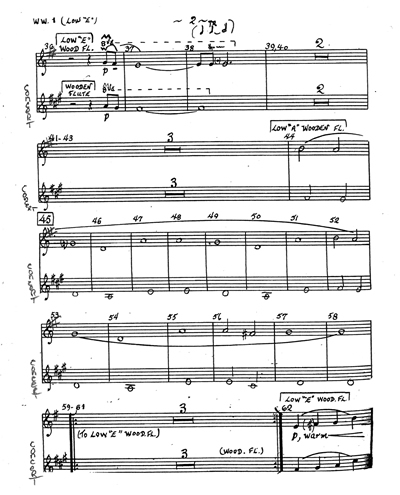Allegro
Keeping It Real
'How do I notate ethnic flutes and woodwinds?'
Volume 114, No. 5May, 2014

Above, a page of notation showing a double staff wood flute part with non-standard transpositions. The part has concert pitch on the bottom, and the transposed part on top, first for “E” flute (a major-second higher than a C concert flute), and then (at measure 44) for “low A wooden flute,” which is the same range as a Western alto flute. The concert key is F# minor, but both wooden flute parts are written with one sharp in the key. The performer will be able to interpret that key signature and use fingerings that are specific to each flute to produce the correct pitches. This is the preferred notation method.
In my work performing on so-called “ethnic” flutes and woodwinds for live and recording projects, the same questions always come up as I collaborate with composers, orchestrators, and copyists to get a piece ready to be performed or recorded. What’s the best way to notate for these instruments? What are the transpositions? How do we indicate ornamentations?
These questions are all very understandable, since composers don’t use these instruments every day. The transpositions can indeed be unique and a little complicated. But fortunately there are some easy procedures to follow that make notation fairly easy.
One of the main problems is that almost all of these instruments lack the mechanical key system of their Western counterparts. Consequently they only work well in a few keys (as little as one or two), as opposed to contemporary Western fully chromatic woodwinds. This means it’s important to keep on hand a lot of instruments in most – if not all – keys. For example: if a composer writes a melody in Ab major for ethnic flute, it’s pretty much impossible to play on a standard keyless wood flute in D (which is the instrument most like the traditional concert C flute). For playing in Ab, a player needs an instrument designed and tuned to Ab, or probably at least a flute in a closely-related key, like Eb or Db.
Another issue is that most of the instruments do not follow the usual transposition procedure we use in Western music, where C is used as the central point for transposition. This is because most of the instruments are (for lack of a better term) “D centered.” Others may be G centered, or even E centered. This is where things start getting rather technical, and it’s best to work directly with the musician to figure out what instrument is right and work out the appropriate transposition.
In fact, before you get into a rehearsal or a session, someone on the music production team should contact the musician directly and discuss the desired instruments. Find out what the musician has available and plan out what can work.
But to really make things run smooth, here’s what I suggest. Ask the composer/orchestrator/copyist to prepare a part that is double staffed. For clarity and consistency, always leave the upper part blank and place the concert-pitched part on the bottom. The musician works out the transpositions on the upper blank staff. Sometimes this involves rewrites in different keys because the instrument choice is not clear until we’ve tried a few things out. This is the system I came up with for the 1991 Broadway production of “Miss Saigon” and refined for the 1997 production of “The Lion King.” The former used four uniquely pitched wood flutes, the latter 13 wood flutes and panpipes as well as concert flute and piccolo. Both productions use this system to this day, both here in New York and worldwide, and other theater productions have adopted it along the way. It has many advantages. The actual concert pitches are always clear to the player and music supervision team, which is vital since the transpositions are unusual. Also, the flute and woodwind players in subsequent domestic and foreign productions should be able to figure out the correct instruments and their transpositions, despite the lack of standardization of key designation for these instruments in different parts of the world. The transpositions will make sense to a professional woodwind player.
Remember that these instruments are “D oriented,” which means that the instruments are designed around a flutist’s “D fingerings,” unlike Western flutes and most woodwinds, which are designed around “C fingerings.” For example, see the notation excerpt printed above. The object is to play in concert F# minor and A major. On the low E wooden flute, if I use D fingerings, I get E major, and if I go up a step and use E minor fingerings, I get the desired F# minor. The middle section moves to A major, where we use a low A wooden flute with D fingerings. There the upper staff key signature should technically change to D major, but we left it as is to avoid confusion.
As far as ornamentation, here it’s best to use standard Western ornament notation to get you in the ballpark, and then let the musician bring his or her experience to make the performance authentic. The default marking I use a lot is the mordent. Lines for slides, glisses and portamento work fine too. Use your instincts – experiment! If you hear a note with a fast upwards gliss at the end (an ornament used often in Chinese music), just write a line that curves up after the note. In actuality, this working out of the part is often one of the most enjoyable parts of the process. It can lead to a lot of positive collaboration among the composer, orchestrator and the musician.
David Weiss performs with the Broadway production of “The Lion King,” freelances for the recording industry, and composes.
